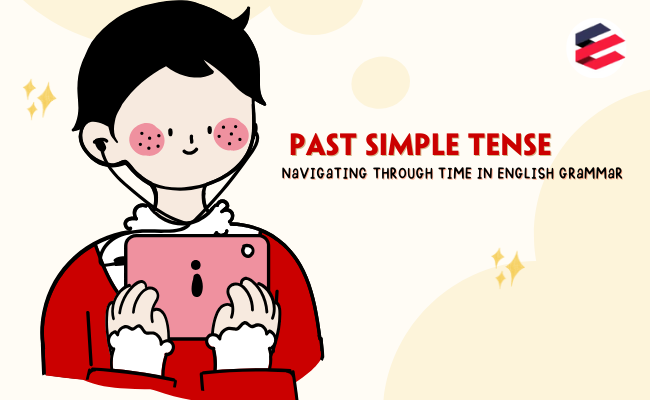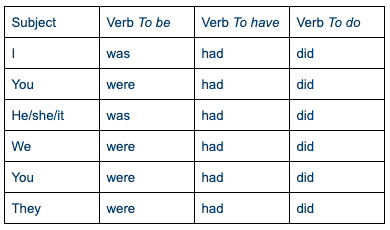Past Simple Tense: Navigating Through Time in English Grammar
In the grand tapestry of language, tenses act as the warp and weft, weaving together the fabric of communication and expression. Amongst them, the past simple tense emerges as a foundational thread, stitching our narratives through time. It is the tense that breathes life into our stories of yesteryears, painting vivid pictures of bygone moments.
As we embark on this linguistic exploration, let us unravel the intricate patterns and significance of the past simple tense – a gateway to our shared history and a fundamental element of our linguistic journey. Through its distinct structure, usage, and historical context, we shall delve into the essence of how the past simple tense shapes our language and our understanding of the past.

1. What is the Past Simple Tense?
The past simple tense, often referred to as the simple past tense, is a grammatical structure used to express actions, events, or situations that occurred and were completed at a specific point in the past. It is one of the basic tenses in English and plays a fundamental role in narrating past events.
2. Structure of the Past Simple Tense
The structure of the past simple tense is relatively straightforward, and it varies depending on whether the subject is regular or irregular:
2.1. Affirmative Form (Regular Verbs)
Subject + Past Tense Verb (e.g., He visited the museum.)
2.2. Affirmative Form (Irregular Verbs)
Subject + Irregular Past Tense Verb (e.g., She went to the party.)
2.3. Negative Form (Regular and Irregular Verbs)
Subject + Did not (didn’t) + Base Form of the Verb (e.g., They didn’t eat lunch.)
2.4. Interrogative Form (Regular and Irregular Verbs):
Did + Subject + Base Form of the Verb + ? (e.g., Did you see the movie?)
3. Usage of the Past Simple Tense
The past simple tense is employed for several purposes:
Narrating Past Events: It is commonly used in storytelling, narratives, or historical accounts to describe actions or events that have already happened. For example, “Once upon a time, there lived a brave knight.”
Talking About Completed Actions: When discussing actions or events that occurred at a specific point in the past and were completed, the past simple tense is the go-to choice. For instance, “She finished her homework yesterday.”
Stating Facts or Habits in the Past: It can be used to describe past facts or habitual actions that occurred regularly in the past. For example, “They always went for a walk after dinner.”
Reporting Direct Speech: When quoting someone’s words directly, the past simple tense is used to maintain the integrity of the original statement. For instance, “She said, ‘I love this book.'”
Expressing Politeness or Modesty: In polite or modest requests or expressions, the past simple tense can be employed. For example, “I was wondering if you could help me.”
>> Suggested article: Present perfect continuous tense

4. What is the past simple role in the IELTS test?
The past simple tense plays a significant role in the IELTS test, which assesses a candidate’s proficiency in using the English language in various contexts. Here’s how the past simple tense is relevant in different sections of the IELTS test:
4.1. Speaking Section
In the IELTS Speaking test, candidates may use the past simple tense to talk about their past experiences, past events, or past actions. For example, they might describe a recent trip they took, recount a memorable childhood event, or discuss a book they read in the past.
It’s essential to use the past simple tense correctly to effectively communicate details about one’s past and convey experiences accurately.
4.2. Writing Section
In the IELTS Writing test, the past simple tense is frequently used when describing trends or historical data in Task 1 of the Academic module. Candidates might be asked to interpret and summarize information from charts, graphs, or tables that represent past events or trends.
Additionally, in Task 2 of both the Academic and General Training modules, candidates may use the past simple tense when providing examples, anecdotes, or historical references to support their arguments or ideas.
4.3. Listening Section
In the IELTS Listening test section, candidates encounter various audio materials, including conversations, interviews, and lectures. The past simple tense is used in these recordings when speakers discuss past events, experiences, or historical facts.
Understanding the past simple tense in spoken English is crucial for accurately answering questions based on the audio materials.
4.4. Reading Section
The Reading test includes passages that may contain sentences or paragraphs in the past simple tense. Candidates need to recognize and understand the use of this tense in written texts to comprehend the context and answer questions correctly.
It’s important for candidates to identify when the events or actions described in the reading passages occurred in the past and to be able to relate this information to the questions asked.

5. Challenge yourself with the present perfect continuous tense exercise
Exercise 1: Fill in the blanks with the appropriate form of the verb in the past simple tense:
She __________ (visit) her grandmother last weekend.
They __________ (play) soccer yesterday.
He __________ (read) an interesting book last night.
We __________ (travel) to France last summer.
The dog __________ (bark) loudly during the night.
Answers:
visited
played
read
traveled
barked
Exercise 2: Rewrite the sentences, changing them from the present simple tense to the past simple tense:
I read books every day.
She visits her grandparents on Sundays.
They play basketball after school.
The sun rises in the morning.
He teaches English at the language school.
Answers:
I read books every day. → I read books yesterday.
She visits her grandparents on Sundays. → She visited her grandparents last Sunday.
They play basketball after school. → They played basketball after school.
The sun rises in the morning. → The sun rose in the morning.
He teaches English at the language school. → He taught English at the language school.
Exercise 3: Form questions using the past simple tense for the following statements:
They watched a movie last night.
She cooked dinner for her family.
He completed the project on time.
We visited the museum on Saturday.
I read an exciting novel last month.
Answer:
Did they watch a movie last night?
Did she cook dinner for her family?
Did he complete the project on time?
Did we visit the museum on Saturday?
Did I read an exciting novel last month?
The essay delves into the linguistic construct of the past simple tense, a crucial element in the grammar for IELTS and English grammar that allows us to narrate and express actions or events that occurred and concluded in the past. It unfolds the definition and structure of the past simple tense, showcasing its fundamental role in recounting historical events and shaping our narratives.
The essay illuminates its various uses, from narrating past events to stating historical facts, and its role in everyday communication. It also highlights the importance of the past simple tense in the context of the IELTS test, demonstrating how its mastery is essential for effective language usage in diverse scenarios. Through exercises and explanations, the essay challenges readers to engage with and enhance their understanding of this fundamental tense, acknowledging its significance in language and literature. Let’s start the IELTS practice test now!